Insect Repellents
Insect repellents are a key component in preventing malaria, complementing the range of insect repellents like sprays, lotions, and creams, as well as wristbands and patches designed to keep biting insects at bay. Read More…

-
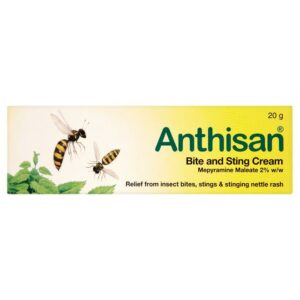
Anthisan Bite and Sting Cream 20g
- Treats pain, itching and inflammation caused by insect stings, bites and nettle rash
- Buy With Confidence From UK Registered Pharmacy
- Next Day Delivery Available
£4.99 Add to basket -
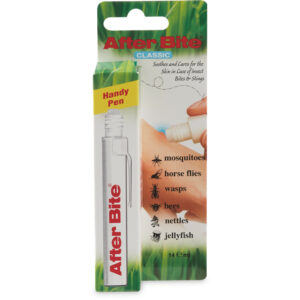
After Bite Insect Bite Relief – 14ml
- Fast Effective Relief Against Bites & Stings
- Buy With Confidence From UK Registered Pharmacy
- Next Day Delivery Available
£4.50 Add to basket -
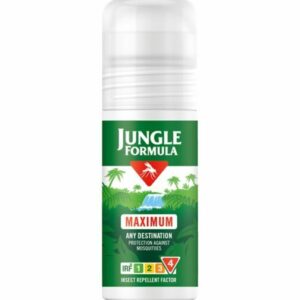
Jungle Formula Natural Roll On 50ml
- Jungle Formula Maximum Roll On repels mosquitoes and biting insects
- 8 Hours Protection Against Bites
- Buy With Confidence From UK Registered Pharmacy
£8.69 Add to basket -
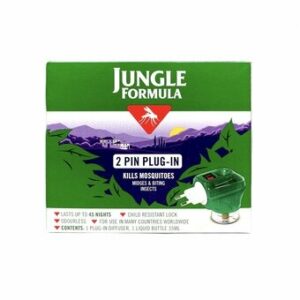
Jungle Formula Mosquito Killer Plug In
- Kills Mosquitoes And Biting Insects
- Lasts For 45 Days, 8-10 Hours Per Night
- Suitable From 8 Years And Over
£15.99 Add to basket -
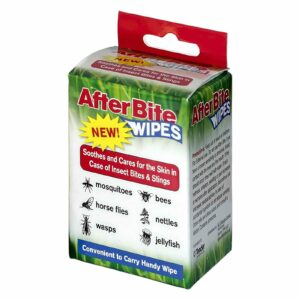
AfterBite Wipes (15)
- Convenient To Carry
- Suitable From 2 Years And Over
- Buy With Confidence From UK Registered Pharmacy
£9.69 Read more -
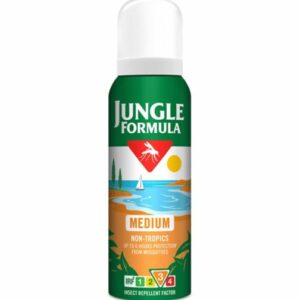
Jungle Formula Medium Aerosol 125ml
- Lasts Up To 6 Hours
- 20% DEET
- Suitable From 12 Years And Over
£13.79 Read more -
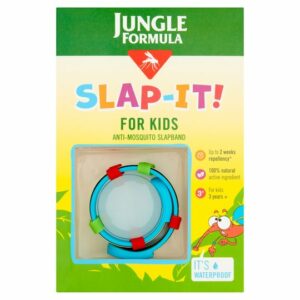
Jungle Formula Slap-It Band For Kids
- Protection From Mosquitoes And Biting Insects
- DEET Free Repellent
- Suitable From 3 Years And Over
£11.29 Add to basket -
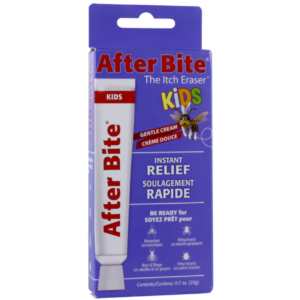
After Bite Kids – 20g
- Instant relief from insect bites
- Be ready for mosquitoes, bees & wasps, and other insects
- Paraben free
£4.99 Read more -
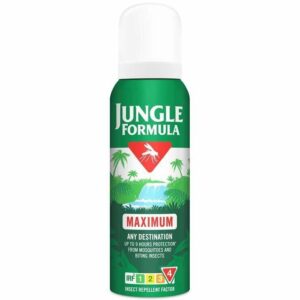
Jungle Formula Maximum Aerosol – 125ml
- Lasts up to 9 hours
- Insect repellent factor 4
- 50% DEET
£12.99 Add to basket
-
About Insect Repellents
Insect repellents are a vital defense against mosquitoes and other biting insects that may carry diseases such as malaria, Zika, or Lyme disease. Repellents come in various forms, including sprays, lotions, creams, wristbands, and patches, and their effective use can significantly reduce the risk of insect-borne illnesses. It’s important to choose a repellent that is suitable for your specific situation and to use it according to the product’s directions.
The efficacy of insect repellents can vary based on their active ingredients. Common ingredients include DEET, icaridin (also known as picaridin or Saltidin), IR3535, and oil of lemon eucalyptus (OLE). While DEET has been used for many years and is known for its effectiveness, it’s also important to be aware of any skin reactions or potential side effects, particularly with prolonged use. Some natural ingredients like citronella oil, neem oil, and catnip oil are also recognized as insect repellents, but their effectiveness and approval for use may vary by region.
When using any repellent, it’s crucial to follow the label instructions carefully. This includes applying it only to skin not covered by clothing, avoiding overuse, and not applying it to wounds or irritated skin. After use, especially if repellents are used daily, it’s advisable to wash the skin with soap and water.
In addition to repellents, protective clothing and keeping the environment free of standing water where mosquitoes breed are also key strategies in preventing insect bites.
-
Symptoms
The need for insect repellents often arises due to symptoms caused by insect bites. These symptoms can vary depending on the type of insect and the individual’s reaction to the bite:
Mosquito Bites: Symptoms can include an itchy, inflamed bump that forms a few minutes after the bite, a painful spot resembling a hive that forms within 24 hours, and small blisters. In severe cases, a large, swollen area or a hive-like rash may develop, and swelling around the eyes can occur, especially in children.
Bee and Wasp Stings: A sharp pain followed by a burning sensation is common, which then turns into a major itch. A red ring or bump typically appears at the site of the sting. Redness and swelling generally peak within 2 to 4 days and resolve about a week after the sting.
Tick Bites: While ticks themselves cause no symptoms while biting, they can transmit diseases like Lyme disease and Rocky Mountain spotted fever. Serious complications from tick bites usually occur after the tick has been attached for at least 24 hours.
Lyme disease symptoms may not appear immediately, while RMSF symptoms include fever, headache, malaise, body aches, and rash.
Insect repellents are recommended to prevent these symptoms and reduce the risk of contracting diseases transmitted by insects. When using repellents, it’s essential to choose products containing approved active ingredients like DEET, picaridin, or oil of lemon eucalyptus, and to follow the instructions carefully.
-
Diagnosis
The diagnosis of diseases transmitted by insect bites typically involves a combination of physical examination, review of symptoms, and laboratory tests. Here’s how these diseases are generally diagnosed:
Physical Exam and Symptom Review: Doctors start by examining the bite site and discussing symptoms and recent travel history with the patient to assess the risk of specific insect-borne diseases.
Blood Tests: Laboratory tests, including blood and urine tests, play a crucial role in diagnosing many insect-borne diseases. These tests can detect the presence of specific pathogens, such as bacteria or viruses, that are transmitted by insects.
Specific Diagnostic Tests: Depending on the suspected disease, additional specialized tests may be required. For example, Lyme disease is often confirmed through blood tests that detect antibodies to the bacteria that cause the disease.
Geographic and Environmental Considerations: The diagnosis can also be influenced by the patient’s travel history and exposure to environments where certain insects are prevalent.
It’s important to consult a healthcare provider if you suspect you have been exposed to an insect-borne disease, as early diagnosis and treatment are crucial for many of these conditions.
-
Treatments
Over-the-counter repellents are a significant part of preventing insect-related diseases. They are formulated with various active ingredients that have been shown to be effective in repelling insects. For example, DEET and Picaridin are two ingredients that offer long-lasting protection. They work by blocking the olfactory receptors of biting insects, making it difficult for them to locate humans.
Permethrin, which is not intended for direct skin application, is available as a spray for clothing and gear, providing protection from ticks, chiggers, mosquitoes, and other arthropods. It remains active for several weeks and retains efficacy even after laundering.
Highlighted over the counter products from My Pharmacy:
Anthisan Bite and Sting Cream: This cream is aimed at treating the pain, itching, and inflammation associated with insect bites and stings.
After Bite Insect Bite Relief: Provides fast relief from insect bites and stings, which can be an immediate concern post-bite.
Jungle Formula Natural Roll On: Offers a natural form of protection against mosquitoes and other biting insects, and is available as a convenient roll-on.
Jungle Formula Mosquito Killer Plug-In: A device designed to kill mosquitoes and biting insects, suitable for indoor use to create a safer sleeping environment.For effective use, these repellents should be applied to exposed skin and clothing as directed. It’s also advisable to use the correct amount for the time you’ll be outdoors, and to reapply as directed by the product instructions. Remember to wash the treated skin with soap and water once you’re back indoors.
-
Prevention Strategies
To effectively prevent insect bites and the diseases they may carry, incorporating the following strategies is crucial:
Use of EPA-registered insect repellents: Products containing DEET, Picaridin, IR3535, Oil of lemon eucalyptus (OLE), Para-menthane-diol (PMD), or 2-undecanone are highly recommended for their proven efficacy and safety. These should be applied to exposed skin, adhering strictly to the guidelines on the product label for reapplication and combined use with sunscreen.
Wearing appropriate clothing: Opt for long-sleeved shirts and long pants, which provide a physical barrier against biting insects.
Treatment of clothes with permethrin: Applying a 0.5% permethrin solution to clothing and gear can offer added protection. Permethrin-treated items retain their repellent properties through multiple wash cycles.
Maintaining a dry environment: Regularly emptying containers that hold water and ensuring your property is devoid of standing water can significantly reduce mosquito breeding sites.
Securing the home: Implement the use of well-maintained window and door screens and consider using air conditioning to minimize indoor insect presence.
Staying aware of peak insect activity times: Since insects like mosquitoes are most active from dusk till dawn, it’s wise to limit outdoor activity during these periods or ensure proper protective measures are in place.
Using mosquito nets: When sleeping in areas with a high prevalence of biting insects, mosquito bed nets can offer effective protection.These preventative measures, alongside keeping a clean environment and refraining from using strong perfumes or scents that attract insects, form a solid defense against insect bites.












